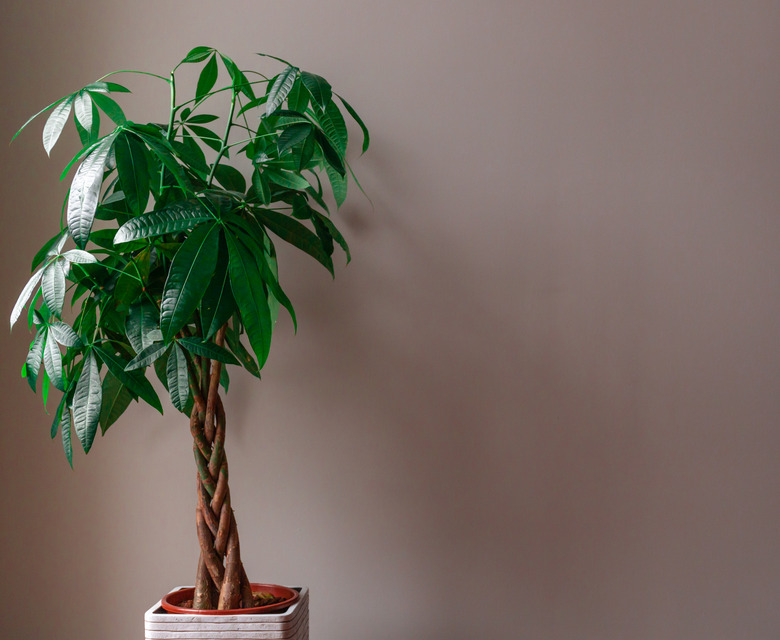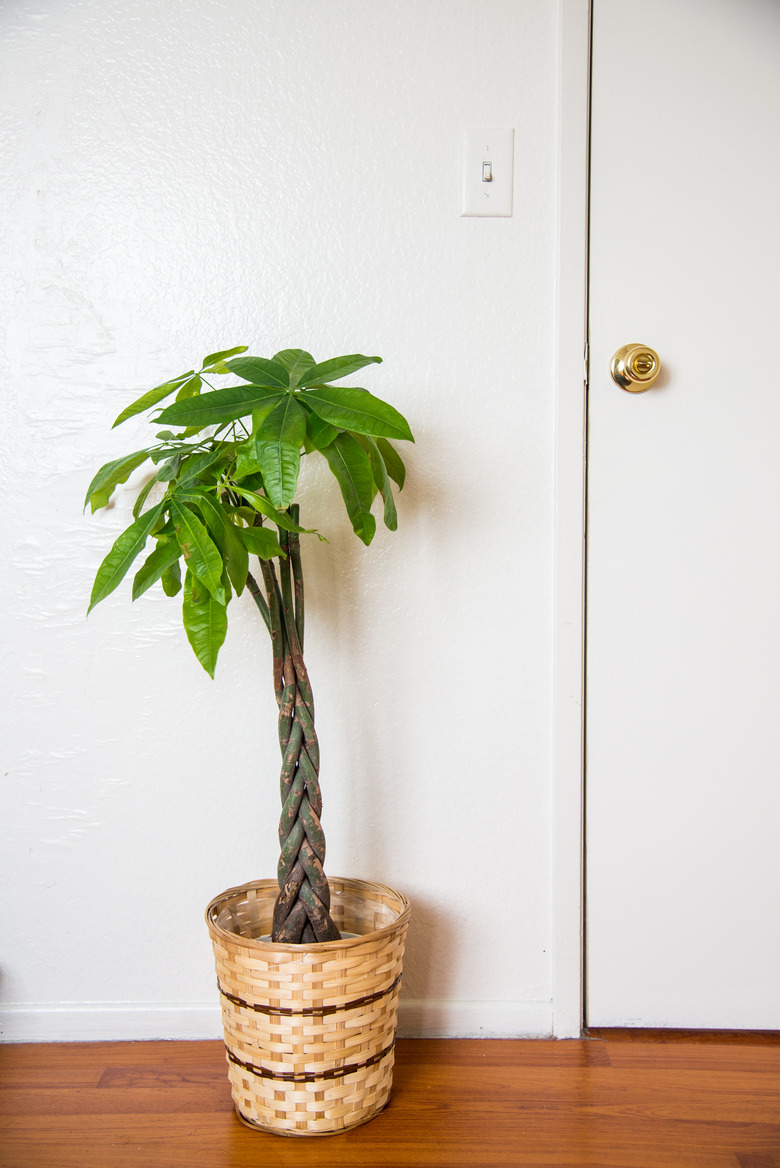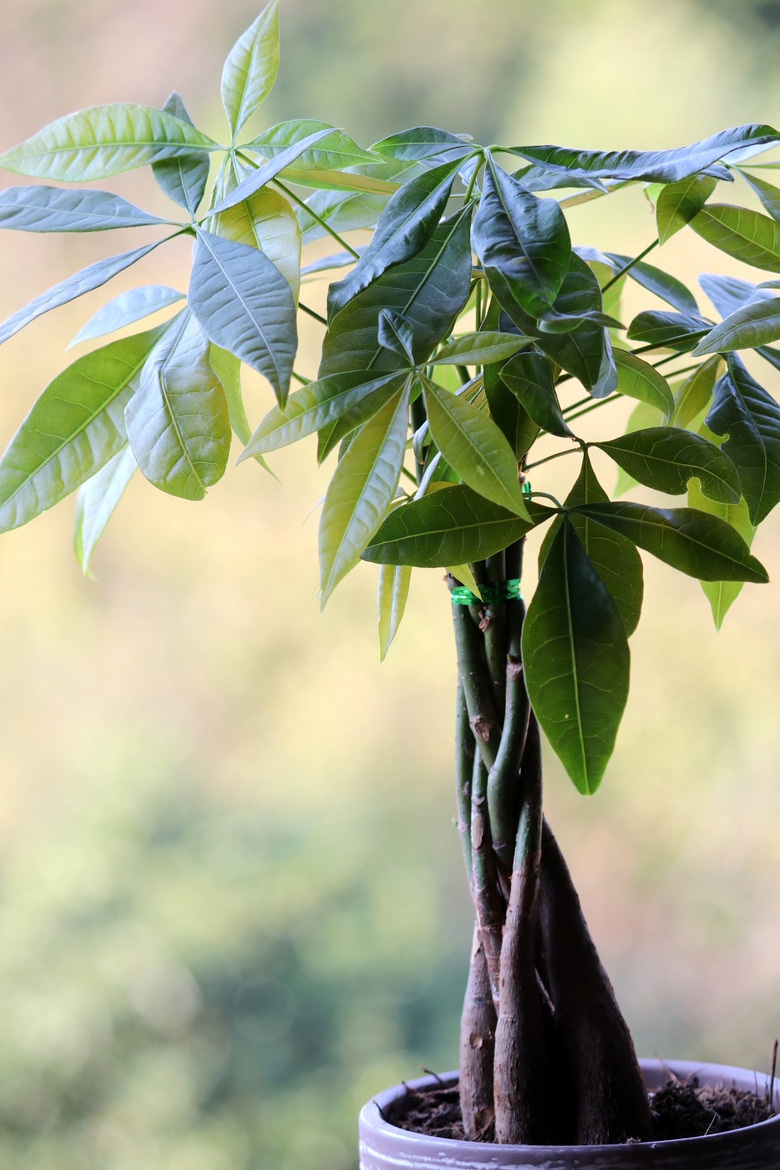How To Care For A Money Tree
We may receive a commission on purchases made from links.
If you're searching for a houseplant with a unique look, the umbrella-shaped money tree (Pachira aquatica) is an ideal pick. Its braided trunk gives it an exotic aesthetic, it's fairly affordable and it's easy to find, making it a popular houseplant choice. Because it's thought to bring good luck and good vibes — money included — to its owner, it's also commonly passed on as a gift.
Whether you've received a money tree plant as a gift or plan to buy one for yourself, know that this plant requires plenty of humidity thanks to its tropical origins. Be careful not to confuse the flat-leaved money tree for its succulent cousin with an identical nickname. The jade plant (Crassula ovata), a feng shui houseplant, is sometimes called a money plant because of its supposed lucky qualities. However, it looks different and has distinct needs.
Best Uses for Money Trees
Best Uses for Money Trees
A money tree is a houseplant best suited to humid conditions — making a potted money tree perfect for livening up a bathroom. Because the kitchen also tends to be higher in humidity than other locations in the home, it's another solid spot for a money tree. This houseplant isn't a great choice for a windowsill display, however, since too much direct sunlight can cause leaf burn and can stress the plant. Money trees also prefer warm weather, so avoid placing your potted tree too close to your front or back door if you live in a cooler climate. Ideally, you'll choose a permanent spot for your money tree right when you take it home because moving it around can stress it out and cause the plant to drop its leaves.
How to Care for Money Trees
How to Care for Money Trees
Money trees require plenty of humidity and sunlight. They're a bit more care intensive than some houseplants, like succulents, but they don't need direct sunlight, making the plants suitable for multiple indoor growing locations.
- Common Name: Money tree
- Botanical Name: Pachira aquatica
- Sun Exposure: Bright, indirect sunlight
- Soil Type: Fertile soil mixed with peat moss
- Mature Size: Up to 30 feet in the wild, but houseplants typically top out at about 6 feet. Container size largely dictates a money tree's height.
- When it's in Trouble: Leaves are falling off, the tree is too tall and it lacks top foliage. Yellowing leaves may also be a sign of stress related to overwatering.
- When it's Thriving: Dark green leaves are shiny and healthy with lush top foliage.
Soil, Light and Water Recommendations for Money Trees
Soil, Light and Water Recommendations for Money Trees
Your money tree needs fertile soil to thrive, so make sure you start it off with a quality potting mix that contains plenty of nutrients. The soil mix should drain well to prevent waterlogging since money trees are prone to root rot.
Money trees require abundant, bright light but don't do well in direct sunlight. Too much direct sunlight can burn the leaves. Money trees can also handle a fair bit of shade. Less sunlight typically means slower overall growth.
In addition to plenty of sunlight, money trees also need high humidity conditions to remain happy and healthy. Periodic misting may help increase humidity the level. However, if you live in a very dry climate or run your drying furnace when you're caring for it in the winter months, you may need to enlist the help of a humidifier to keep your money plant satisfied. Watering is essential to maintain the humidity level, but you'll need to strike a fine balance. Too much water can result in root rot, and too little water can cause your plant to dry out.
If you're not sure whether you're overwatering, cut back temporarily on watering to see if your plant's appearance improves. Leaves should be moist; this can be achieved with misting, but roots should never soak in water. When you first get your plant, water thoroughly — enough to moisten the soil. Only water again once the soil has dried out. Repeat the process to meet your money tree's watering needs. You're better off planting your tree in a pot with drainage holes and using a saucer so you can empty excess water and prevent roots from sitting in pooled water.
In the summer, it's OK to move your money tree to an outdoor area. Just make sure it's not sitting in direct sunlight. When you bring the plant back in for the winter, check for pests before setting it back in its indoor spot. Money trees cannot survive the winter outside in USDA hardiness zones below 10.
Fertilizer Recommendations for Money Trees
Fertilizer Recommendations for Money Trees
Fertilize with a balanced liquid plant food about once every month during the active growing season. In winter, stop fertilizing. Fertilizing in winter is not recommended because plants receive fewer hours of sunlight and can't synthesize nutrients at the same rate they do during the growing season. The result is weak growth and lanky plants.
Humidity and Temperature Recommendations for Money Trees
Humidity and Temperature Recommendations for Money Trees
A too-dry environment can cause leaf drop and plant stress. High humidity is critical for money trees. These tropical plants need consistently high humidity levels, which you can achieve with a humidifier. Misting can also help but may not be enough in an ultra-dry home.
Alternatively, you can place pebbles on a tray next to your plant and cover them with water. The evaporating water will provide some humidity for your money tree. That said, nothing beats a humidifier. It's your best bet for raising humidity levels to satisfy tropical plants.
Money trees also like it warm and prefer temperatures between 60 and 75 degrees Fahrenheit. Remember that adjusting your thermostat in the winter will boost the temperature but will also affect humidity levels. If you're not sure whether the humidity in your home is at an appropriate level, grab yourself a battery-operated hygrometer.
Because money trees love warmth and humidity, a bathroom is an ideal spot for these tropical houseplants as long as the bathroom provides enough indirect sunlight. A covered veranda is another good spot as long as it stays warm enough. Keeping your money tree away from windowsills is also recommended. Windowsills can provide too much sunlight and can burn plant leaves. Those that are poorly insulated and let in drafts may shock and stress your money tree.
How to Prune Money Trees
How to Prune Money Trees
Pruning your money tree helps encourage growth. Removing unhealthy branches and leaves also keeps your tree looking neat and tidy. For best results, prune branches in the spring when your plant is likely to set new growth.
You should prune when your money tree is becoming too lanky or too large for its pot. Pruning helps reshape growth and keep the plant manageable. First, remove any dead or wilted leaves using sharp gardening shears that have been disinfected. If you are cutting branches that jut out from the main stem, slice right below the spot where they form a "V" shape. Remove smaller, flimsier branches on the sides or top of the tree. Only remove up to half of the foliage as pruning too much can stress your plant.
Potting (and Repotting) Money Trees
Potting (and Repotting) Money Trees
Most houseplants benefit from periodic repotting. That doesn't mean, however, you have to upgrade to a larger pot each and every time. If you grabbed a bigger pot every time you needed to repot, you'd end up with a massive container. When you repot a money tree, it involves refreshing the soil and ensuring your plant isn't root-bound. For money trees, repotting should be done every two or three years on average. Get rid of the old soil and refresh with all new potting mix regardless of whether or not you're actually changing the pot.
How to Propagate Money Trees
How to Propagate Money Trees
Money trees are exceptionally easy to propagate in water. You can't grow them forever in an entirely aquatic environment, but starting cuttings in water is simple. To get started, you'll need rooting hormone. Apply the product to the end of the stem you intend to propagate and pop it into a water-filled vase or glass. Place the cutting in a bright, warm location and wait for roots to start appearing. Wait a few weeks until the root system has developed and then transfer the cutting to soil.
When selecting a stem for propagation, make sure it looks healthy. The leaves should be glossy and bright green and your cutting should be about 6 inches in length with at least two leaf nodes at its base. These leaf nodes will produce your cloned plant's roots. Cut the stem right below the leaf nodes, cutting at an angle. You can take multiple cuttings but be sure not to take too many to prevent stressing your plant.
You can also root cuttings directly in soil following the same process. The downside to starting off this process in soil is that you can't check whether any roots are actually forming.
If you want to share cuttings with a friend or neighbor, wrap them in a damp paper towel. Give them to your money tree recipient within a day to prevent the cutting from drying out.
Common Pests and Other Problems for Money Trees
Common Pests and Other Problems for Money Trees
Money trees are magnets for common houseplant pests, such as mealybugs, aphids and spider mites. Prevent these types of pest infestations by checking your plant periodically for signs of pest activity. To prevent a pest problem in the first place, never bring home plants without also checking for pests under their leaves and along their stems.
Overwatering is also a common problem for money trees — because they like high humidity, people tend to overwater them in an effort to meet their moisture needs. Money trees don't like to sit in water. Before watering a money tree, check whether the soil is moist. If it's completely dry, it's OK to water until the topsoil is moist. Only water again when the soil dries out. In between, you'll still need to keep humidity levels high to prevent leaves from browning and drooping. If you're underwatering, you're likely to notice leaf drop.
Common Diseases for Money Trees
Common Diseases for Money Trees
Root rot is a disease that commonly affects money trees. Avoid it by potting your tree in a pot with drainage holes and using a saucer. A little while after watering, check on your plant to see if you need to empty the saucer.
Other diseases include anthracnose and white powdery mildew. Anthracnose is a disease that causes leaf spot. Plants watered from above (instead of directly into the soil) are most susceptible to the disease. A copper fungicide is your best bet for combatting anthracnose. White powdery mildew appears as white powdery spots on foliage. Neem oil is the treatment of choice to combat this fungal infection.
References
- The Healthy Houseplant: Growing & Propagating Money Trees in Water
- Sunday Gardener: Common Pachira Aquatica Problems
- Bloomscape: Money Tree Care
- LawnStarter: Caring for a Money Tree Plant Takes More Than Good Luck
- LuEsther T. Mertz Library: How Do I Care For My Money Tree Houseplant?
- MasterClass: How to Properly Care for a Money Tree Houseplant
- Missouri Botanical Garden: Pachira aquatica


